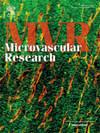Transplantation of autologous endothelial progenitor cells promotes the repair of fusiform aneurysms
IF 2.7
4区 医学
Q2 PERIPHERAL VASCULAR DISEASE
引用次数: 0
Abstract
Endothelial progenitor cells (EPCs), which are precursors for endothelial cells, possess the capability of repairing vascular damage and predicting the extent of early vascular injury. However, the role of EPCs in the repair of fusiform aneurysms is not clear. Here, we constructed a fusiform aneurysm model using pancreatic elastase digestion and validated the improvement effect of EPCs through histological staining and immunofluorescence. HE staining and elastic fiber staining showed destruction of the tunica adventitia in the fusiform aneurysm, marked dilatation of the arterial lumen, and thinning of the elastic lamina in the fusiform aneurysm. In the fusiform aneurysm group, the concentration of vascular endothelial growth factor (VEGF) was notably decreased compared to both the control and the saline group. The level of EPCs in the peripheral blood was decreased in the model group. Transplantation of EPCs into fusiform aneurysms promoted vascular repair, indicated by the decrease of myeloperoxidase (MPO), advanced oxidation protein products (AOPP), matrix metalloproteinase-9 (MMP-9), platelet factor 4 (PF4), and Fe2+. The level of VEGF was also elevated after EPCs transplantation. Finally, we noted a marked rise in lactate level in the peripheral blood of fusiform aneurysms. Lactate treatment led to an elevation of H3K18la levels in EPCs and inhibited cell proliferation. In conclusion, this study discovered that in mice with fusiform aneurysms, elevated lactate levels in the peripheral blood trigger histone lactylation, such impeding the proliferation of EPCs. Transplantation of EPCs into fusiform aneurysms facilitated aneurysm repair. These findings lay the groundwork for EPCs in the treatment of fusiform aneurysms.
自体内皮祖细胞移植促进梭状动脉瘤的修复。
内皮祖细胞(Endothelial progenitor cells, EPCs)是内皮细胞的前体,具有修复血管损伤和预测早期血管损伤程度的功能。然而,内皮祖细胞在梭状动脉瘤修复中的作用尚不清楚。本研究采用胰腺弹性酶消化法构建梭状动脉瘤模型,并通过组织染色和免疫荧光验证EPCs的改善作用。HE染色和弹性纤维染色显示梭状动脉瘤外膜破坏,动脉管腔明显扩张,梭状动脉瘤弹性层变薄。梭状动脉瘤组血管内皮生长因子(VEGF)浓度较对照组和生理盐水组明显降低。模型组大鼠外周血EPCs水平降低。EPCs移植梭状动脉瘤促进血管修复,表现为髓过氧化物酶(MPO)、晚期氧化蛋白产物(AOPP)、基质金属蛋白酶-9 (MMP-9)、血小板因子4 (PF4)和Fe2+的降低。内皮祖细胞移植后VEGF水平升高。最后,我们注意到梭状动脉瘤外周血乳酸水平显著升高。乳酸处理导致EPCs中H3K18la水平升高并抑制细胞增殖。总之,本研究发现,在梭状动脉瘤小鼠中,外周血乳酸水平升高会触发组蛋白乳酸化,从而阻碍EPCs的增殖。梭状动脉瘤内内皮祖细胞移植促进动脉瘤修复。这些发现为EPCs治疗梭状动脉瘤奠定了基础。
本文章由计算机程序翻译,如有差异,请以英文原文为准。
求助全文
约1分钟内获得全文
求助全文
来源期刊

Microvascular research
医学-外周血管病
CiteScore
6.00
自引率
3.20%
发文量
158
审稿时长
43 days
期刊介绍:
Microvascular Research is dedicated to the dissemination of fundamental information related to the microvascular field. Full-length articles presenting the results of original research and brief communications are featured.
Research Areas include:
• Angiogenesis
• Biochemistry
• Bioengineering
• Biomathematics
• Biophysics
• Cancer
• Circulatory homeostasis
• Comparative physiology
• Drug delivery
• Neuropharmacology
• Microvascular pathology
• Rheology
• Tissue Engineering.
 求助内容:
求助内容: 应助结果提醒方式:
应助结果提醒方式:


